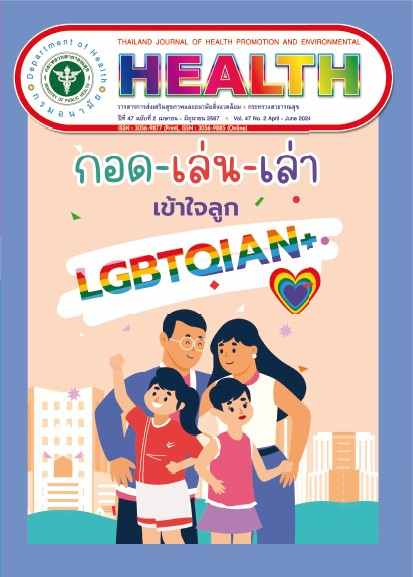การจัดบริการด้านสุขภาพช่องปากในผู้สูงอายุ ภายใต้แผนงานทันตสุขภาพสำหรับผู้สูงอายุประเทศไทย (พ.ศ. 2558 - 2565)
คำสำคัญ:
บริการสุขภาพช่องปาก, คุณภาพชีวิตในมิติสุขภาพช่องปาก, ปัจจัยด้านการจัดบริการ, ผู้สูงอายุไทยบทคัดย่อ
การศึกษานี้มีวัตถุประสงค์เพื่อศึกษาผลของแผนงานทันตสุขภาพสำหรับผู้สูงอายุประเทศไทย (พ.ศ. 2558 - 2565) ต่อการจัดบริการด้านสุขภาพช่องปากในผู้สูงอายุ การเข้าถึงบริการทันตกรรม คุณภาพชีวิต และปัจจัยการจัดบริการที่สัมพันธ์กับคุณภาพชีวิตผู้สูงอายุ เป็นการศึกษาเชิงวิเคราะห์ (Analytical study) จากการทบทวนสืบค้นเอกสารราชการ ประกาศ รายงานผลการดำเนินงาน ข้อมูลจากระบบคลังข้อมูลด้านการแพทย์และสุขภาพ(Health Data Center)กระทรวงสาธารณสุข และข้อมูลจากแบบสอบถามผู้สูงอายุในโครงการประเมินผลแผนงานทันตสุขภาพสำหรับผู้สูงอายุประเทศไทย พ.ศ.2558-2565 กลุ่มตัวอย่างจำนวน 4,532 คน วิเคราะห์ผลด้วยโปรแกรมสำเร็จรูป โดยใช้สถิติเชิงพรรณนา และสถิติอนุมาน Pearson correlation, Multiple linear regression ผลการศึกษา เมื่อสิ้นสุดแผนงาน ในปี 2565 พบว่า 1) ผลด้านนโยบายและการจัดบริการ มีบริการสุขภาพช่องปากสำหรับผู้สูงอายุที่ชัดเจน ในหน่วยบริการทุกระดับของกระทรวงสาธารณสุข ครอบคลุมผู้สูงอายุที่ช่วยเหลือตนเองได้ กลุ่มโรคไม่ติดต่อเรื้อรัง กลุ่มพึ่งพิงในระบบการดูแลสุขภาพระยะยาว การเพิ่มสิทธิประโยชน์ในระบบหลักประกันสุขภาพแห่งชาติ ได้แก่ การตรวจช่องปาก ตรวจคัดกรองรอยโรคเสี่ยงมะเร็งและมะเร็งช่องปาก การฝังรากฟันเทียมรองรับฟันเทียมทั้งปาก การพัฒนาทันตบุคลากรหลักสูตรทันตกรรมผู้สูงอายุ การใช้เทคโนโลยีดิจิทัลในการประเมินช่องปากด้วยตนเอง 2) ผลที่เกิดกับกลุ่มเป้าหมาย ผู้สูงอายุเข้าถึงบริการทันตกรรมเพิ่มขึ้นจากร้อยละ 17.2 เป็น 35.6 มีฟันแท้ใช้งานได้ไม่น้อยกว่า 20 ซี่ เพิ่มขึ้นจากร้อยละ 54.9 เป็นร้อยละ 60.5 3) ค่าเฉลี่ยคุณภาพชีวิตในมิติสุขภาพช่องปาก OHIP-14 เท่ากับ 15.84 คะแนน ค่าเบี่ยงเบนมาตรฐาน 7.85 โดยมิติที่มีผลกระทบต่อคุณภาพชีวิตสูงสุด คือ มิติความเจ็บปวดทางกายภาพ และมิติด้านความจำกัดในการทำหน้าที่ 4) ปัจจัยด้านบริการที่มีผลในเชิงบวกต่อคุณภาพชีวิตผู้สูงอายุในมิติสุขภาพช่องปาก อย่างมีนัยสำคัญทางสถิติ (p<0.005) ได้แก่ จำนวนทันตบุคลากรที่ได้รับการอบรมหลักสูตรทันตกรรมผู้สูงอายุในพื้นที่ และจำนวนครั้งของการได้รับบริการของผู้สูงอายุ และปัจจัยที่มีผลในเชิงลบต่อคุณภาพชีวิตด้านสุขภาพช่องปาก คือ อายุที่มากขึ้น และระยะทางจากบ้านไปยังหน่วยบริการที่เพิ่มขึ้น
ดาวน์โหลด
เผยแพร่แล้ว
ฉบับ
บท
การอนุญาต
ลิขสิทธิ์ (c) 2024 วารสารการส่งเสริมสุขภาพและอนามัยสิ่งแวดล้อม

This work is licensed under a Creative Commons Attribution-NonCommercial-NoDerivatives 4.0 International License.

